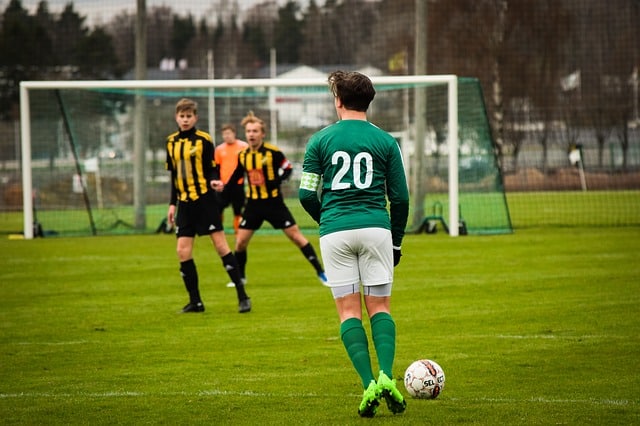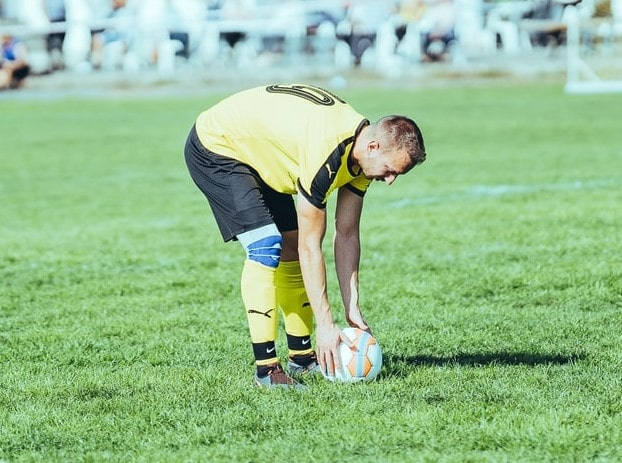Free kicks are a fundamental part of the soccer game. Almost every single professional soccer game has at least a few free kicks in it.
If you watch a full 90 minutes match, it’s almost impossible that you don’t see any free kicks taken during the match.
With that said, it’s essential for every soccer fan/player to know everything there is about free kicks, and that is what this article is for.
In general, free kicks are a way to put the ball back in play after the game stops due to a foul. We’ll talk more about this in more detail later in this article. First we need to address the different types of free kicks in soccer and talk about each one of them.
What are the different types of free kicks?
In soccer, there are 2 different types of free kicks. The direct free kick, and the indirect free kick. These 2 types of free kicks differ in the way that they are played, and in the way that they are called. Each of these 2 kicks has its own use case in soccer.
So, the next thing is to talk about each one of these kicks, and when do they occur during a soccer match.
What is a direct free kick in soccer?
A direct free kick in soccer is a kick taken while the ball is placed stationary on the ground and while all of the opponent players are at least 10 yards (9.15 meters) away from the ball. As the name of the kick implies, a goal can be immediately scored from a direct free kick.
Direct free kicks have been one of the best ways to score a goal. Especially if the kick is taken from a very far distance. A lot of soccer players have managed to score brilliant goals from direct free kicks.
You can check this sports bible list to learn more about the top 10 highest scoring free kick takers in the history of soccer.
When is a direct free kick awarded?
Direct free kicks are awarded for the serious fouls and offences during a soccer game. A direct free kick is given for the fouls that involve physical contact between the players and for other types of fouls. Actions like kicking a player or touching the ball with the hands can lead to a direct free kick.
As a general rule of thumb, if the action that resulted in a foul has a small chance of causing physical damage to one of the players on the field, then a direct free kick is awarded.
In other words, all forms of careless tackles can result in a direct free kick. The same thing goes for handballs (except for the goalkeepers when they are inside their team’s penalty are).
What is an indirect free kick in soccer?
An indirect free kick is one of the set pieces used by soccer to put the ball back in play after the game stops. As the name implies, a goal can’t be scored directly from an indirect free kick. At least one player other than the indirect free kick taker should touch the ball before a goal can be scored.

As a soccer fan watching a game, how can you tell what type of free kick the referee has granted after a foul? The answer is quite simple, you can know using the indirect free kick signal that the referee gives.
But what exactly is the indirect free kick signal?
The referee signals an indirect kick by raising their hand high up in the air and above their head. After the indirect free kick is taken, the referee keeps their hand in the air till another player touches the ball or the ball goes out of play. As long as the referee is giving the indirect kick signal, a goal can’t be scored.
In other words, in order to know whether the awarded kick was direct or indirect, just look at the referee. If they are raising their hand in the air, then it’s an indirect free kick. If they aren’t raising their hand, then it’s a direct free kick.
When is an indirect free kick awarded?
In general, indirect free kicks are awarded for fouls that do not involve physical contact between the players on the field. Actions like using offensive language and playing in a dangerous manner without actually touching the opponent result in an indirect free kick.
For example, if a soccer defender attempts a very reckless tackle, but their opponent manages to escape the tackle, the referee may still decide to stop the game and give an indirect free kick.
The whole point behind the indirect free kicks is that the soccer rules still want to punish the reckless actions during a soccer game even if these actions do not result in any physical contact.
In other words, an attempt to hurt another player is punished even if the attempt failed, and even if the attempt wasn’t intentional at all. In these scenarios, the indirect kick is what’s given.
There are many other scenarios in which an indirect free kick is awarded. For example, if a goalkeeper wastes time by holding the ball in their hands for more than a certain period of time, then the referee blows their whistle and the opponent gets an indirect free kick.
Attempting to take the ball from the goalkeeper in an illegal way can also result in an indirect free kick. Basically, any kind of foul that does not deserve a direct free kick is awarded an indirect free kick instead.
Can a free kick be awarded inside the penalty box?
As you may already know, if a foul takes place inside the penalty area, then a penalty kick is awarded. But, what you may not know is that this is not always the case (surprising right?).
An indirect free kick can be awarded from inside the penalty box. If a player commits a foul that requires an indirect free kick, then an indirect free kick is given and not a penalty kick even if the foul was committed inside the penalty box.
An indirect free kick inside the penalty area is rare in soccer, but it happens every now and then.
But when does this happen?
The indirect free kicks inside the penalty box are mostly caused by goalkeepers breaking the ‘back pass’ rule.
Basically, a goalkeeper can’t touch the ball with their hands after they release it unless one of the opponent players touches the ball first.
If the goalkeeper touches the ball with their hands again after they release the ball, but the ball hasn’t touched any opponent player yet, then an indirect free kick is given to the opponent from the position where the goalkeeper touched the ball, and usually the position is inside the penalty area.
However, there are other scenarios that can cause a free kick to be taken from inside the penalty box. Basically, any indirect free kick awarded inside the penalty area is treated like any other indirect free kick.
Note that direct free kicks do not take place inside the penalty area. If a direct free kick offense happens inside the penalty box, then a penalty kick is awarded instead of a direct free kick.
Before I end this article, here are a few quick notes that you might find useful when it comes to free kicks in general:
- The free kick taker can’t touch the ball after they take the kick unless the ball touches another player. This rule is generally known as the 2 touch rule.
- Any player on the field can take a free kick including the goalkeepers
SUMMARY
Free kicks are either a direct free kick or an indirect free kick. A direct free kick can convert into a goal while an indirect free kick has to be touched by a player other than the free kick taker for a goal to be scored.
Direct free kicks are generally awarded to fouls that involve physical contact between the players while indirect free kicks are awarded for fouls that do not involve physical contact between the players.

